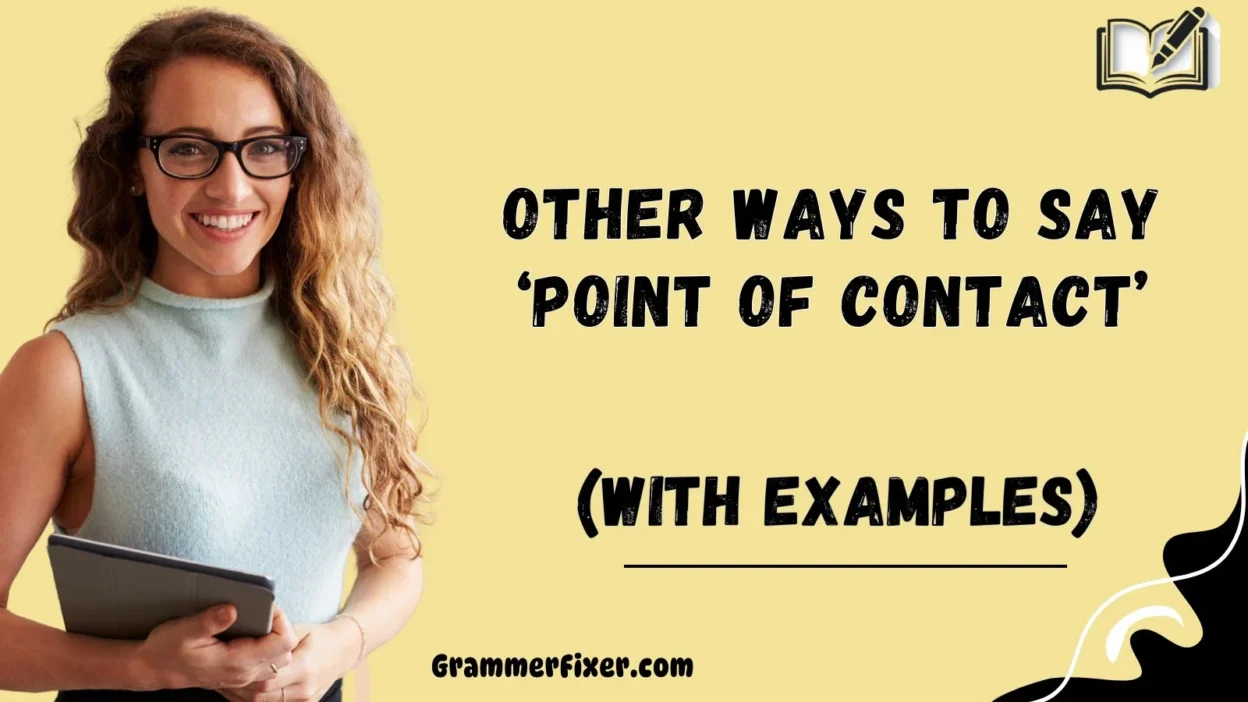In professional communication, the words we choose do more than just convey information—they reflect our intent, tone, and care. Calling someone a “point of contact” is clear, but it can sometimes sound mechanical or distant. Finding the right synonym can make your message feel warmer, more personal, and more professional.
Below are 30 thoughtful alternatives to help you communicate with clarity and empathy, no matter the context.
What Does “Point of Contact” Mean?
The phrase “point of contact” refers to a designated individual or entity responsible for communication, coordination, or connection between groups, departments, or organizations. This role ensures that information is shared efficiently, questions are addressed, and relationships are maintained.
When to Use “Point of Contact”?
Use this term (or an alternative) when:
- You want to assign responsibility for managing inquiries or updates.
- You need to establish clarity in communication channels.
- You’re working on cross-functional projects or with external partners.
- You wish to identify the person accountable for specific communication flows.
Is It Professional / Polite to Say “Point of Contact”?
Yes — it’s professional, polite, and widely accepted. However, it can come across as impersonal in human-centered communication. Using warmer or more contextual synonyms can make your tone sound more approachable and aligned with relationship-building goals.
Pros and Cons of Using “Point of Contact”
Pros:
- Universally understood and clear.
- Neutral, professional tone.
- Works across most industries.
Cons:
- May sound generic or overused.
- Lacks emotional warmth.
- Can feel transactional in relationship-driven contexts.
1. Liaison / Communication Liaison
Meaning: A liaison is someone who connects two or more groups, ensuring smooth communication and mutual understanding.
Explanation: A liaison acts as a bridge between departments, teams, or organizations—helping align goals, clarify misunderstandings, and streamline processes.
Scenario Example:
“Maria will serve as the liaison between our marketing and IT teams during this campaign.”
Best Use:
Use when describing someone facilitating communication and coordination between distinct groups or departments.
Worst Use:
Avoid in informal or one-on-one correspondence (e.g., “I’ll be your liaison for lunch scheduling”)—it may sound overly formal or bureaucratic.
Tone:
Professional, cooperative, and facilitative.
2. Representative / Client Representative
Meaning: A representative is a person authorized to act or speak on behalf of someone else or an organization.
Explanation: The term emphasizes delegated authority and trust, ideal for someone who embodies or conveys the organization’s interests.
Scenario Example:
“For any vendor issues, please reach out to our client representative, Ahmed.”
Best Use:
Perfect when referring to someone empowered to make decisions or respond on behalf of their organization or client.
Worst Use:
Avoid using it for purely administrative or technical roles without decision-making authority—it may imply more power than the role holds.
Tone:
Formal, respectful, and trust-based.
3. Coordinator / Project Coordinator
Meaning: A coordinator organizes people, timelines, and tasks to ensure things move efficiently and on schedule.
Explanation: Beyond communication, this title suggests project ownership and structured management—ideal for task-driven environments.
Scenario Example:
“Rita is our project coordinator—she’ll manage deliverables and keep everyone aligned.”
Best Use:
When you want to emphasize organization, scheduling, and project execution.
Worst Use:
Avoid when referring to someone who only relays messages but doesn’t manage logistics or timelines—it might overstate the role.
Tone:
Structured, methodical, and professional.
4. Account Manager / Client Account Manager
Meaning: A client account manager oversees client relationships, ensuring satisfaction, problem-solving, and alignment with objectives.
Explanation: It blends relationship management with project or business oversight, representing the voice of the client within the organization.
Scenario Example:
“Your account manager, Salman, will help you navigate the onboarding process.”
Best Use:
Ideal for client-facing roles in sales, marketing, or service-based environments.
Worst Use:
Avoid using in internal communications where no client relationship exists—it can sound misplaced or confusing.
Tone:
Consultative, customer-oriented, and polished.
5. Intermediary / Communication Intermediary
Meaning: An intermediary acts as a neutral go-between for two or more parties.
Explanation: Used when discretion, diplomacy, or neutrality is essential—especially in negotiations or conflict resolution.
Scenario Example:
“Jane will act as an intermediary between the operations and compliance teams.”
Best Use:
When managing sensitive discussions, complex negotiations, or cross-departmental communication.
Worst Use:
Avoid using in simple or friendly team communication—it can sound cold or overly formal.
Tone:
Diplomatic, careful, and objective.
6. Spokesperson / Official Spokesperson
Meaning: A spokesperson is an authorized communicator who speaks publicly for an organization or group.
Explanation: It emphasizes public representation, official statements, or external communication.
Scenario Example:
“John will be our official spokesperson for this event.”
Best Use:
Best for media relations, announcements, or formal communications.
Worst Use:
Avoid for internal updates or casual conversations—it may sound inflated or hierarchical.
Tone:
Authoritative, confident, and formal.
7. Connector / Relationship Connector
Meaning: A connector builds relationships and links people together.
Explanation: Highlights a human, relational side of communication rather than strict formalities.
Scenario Example:
“If you’d like to meet our development partners, talk to our connector, Alya.”
Best Use:
Networking, introductions, and community-building contexts.
Worst Use:
Avoid using in formal project management or hierarchical reporting—it might sound too casual.
Tone:
Warm, personable, and approachable.
8. Facilitator / Communication Facilitator
Meaning: A facilitator enables effective communication, decision-making, or collaboration between people or groups.
Explanation: Focuses on the ability to guide discussions, align views, and move conversations forward.
Scenario Example:
“Sam will be the facilitator for our cross-departmental meetings.”
Best Use:
When organizing workshops, collaborative sessions, or cross-team discussions.
Worst Use:
Avoid using for strictly administrative or directive roles—facilitators empower, not command.
Tone:
Encouraging, neutral, and collaborative.
9. Bridge / Communication Bridge
Meaning: A bridge connects two entities, fostering cooperation and understanding.
Explanation: This term emphasizes connection and empathy, often in cross-functional or cross-cultural contexts.
Scenario Example:
“She serves as a bridge between the product and design teams.”
Best Use:
When describing someone who aligns perspectives or mediates across differences.
Worst Use:
Avoid in formal documents or resumes—it may sound too figurative or vague.
Tone:
Symbolic, harmonious, and relational.
10. Primary Contact / Primary Point of Contact
Meaning: The main person responsible for communication or coordination on a topic.
Explanation: Clear and concise, it directly identifies accountability without embellishment.
Scenario Example:
“Your primary contact for onboarding is Khalid.”
Best Use:
Ideal when you need to assign a clear communication lead.
Worst Use:
Avoid overuse in friendly introductions (“I’m your primary contact for lunch updates”)—it may sound stiff.
Tone:
Direct, reliable, and formal.
11. Main Contact / Main Point of Contact
Meaning: The central person responsible for overseeing communications or updates in a specific matter.
Explanation: This term mirrors “primary contact” but with slightly more conversational flexibility. It highlights the person’s importance without sounding overly corporate.
Scenario Example:
“I’ll remain your main contact throughout the duration of this project.”
Best Use:
Use when you want to emphasize reliability and accessibility in managing relationships or updates.
Worst Use:
Avoid using when several people are equally involved—it may misrepresent shared responsibility.
Tone:
Friendly, dependable, and professional.
12. Go-To Person
Meaning: A trusted individual everyone turns to for guidance, information, or solutions.
Explanation: This term implies both competence and reliability, making it feel warm and approachable in tone.
Scenario Example:
“For any technical questions, Jenna is our go-to person.”
Best Use:
Great for informal team communication or describing someone with recognized expertise.
Worst Use:
Avoid in formal reports or corporate documents—it may sound too casual.
Tone:
Informal, approachable, confident.
13. Delegate
Meaning: A person appointed or entrusted to act on behalf of someone else or a group.
Explanation: Suggests authority and trust, often used in structured or hierarchical organizations.
Scenario Example:
“Michael will act as the delegate for our department during the regional summit.”
Best Use:
Ideal for formal, government, or conference contexts where representation is key.
Worst Use:
Avoid for everyday team coordination—it may sound overly official.
Tone:
Formal, authoritative, and composed.
14. Agent
Meaning: A representative or intermediary authorized to act on behalf of another party.
Explanation: Commonly used in sales, contracts, or negotiations, emphasizing transactional clarity and representation.
Scenario Example:
“Our agent, Rebecca, will coordinate all contract-related inquiries.”
Best Use:
When referring to business dealings, partnerships, or client-facing transactions.
Worst Use:
Avoid in casual correspondence—it might sound too commercial or distant.
Tone:
Professional, assertive, and neutral.
15. Designated Contact
Meaning: The assigned individual responsible for handling a particular topic, client, or task.
Explanation: This phrasing ensures clarity and accountability, emphasizing that the person is officially appointed.
Scenario Example:
“Sarah has been appointed as your designated contact for this onboarding process.”
Best Use:
When clarity and formality are priorities—especially in structured workplaces.
Worst Use:
Avoid using in friendly introductions or informal team settings—it can sound bureaucratic.
Tone:
Clear, official, and structured.
16. Facilitating Officer
Meaning: A professional liaison ensuring smooth communication and operational flow.
Explanation: This term is suited for corporate, government, or large-scale project environments, reflecting coordination at a higher level.
Scenario Example:
“Our facilitating officer, Mr. Rehman, will oversee all logistical arrangements.”
Best Use:
When referring to someone in a formal or authoritative coordination role.
Worst Use:
Avoid for small teams or casual settings—it may sound inflated.
Tone:
Authoritative, procedural, and diplomatic.
17. Relationship Manager
Meaning: A person responsible for nurturing and maintaining professional relationships with clients or partners.
Explanation: This role blends interpersonal communication with strategic engagement.
Scenario Example:
“Your relationship manager, Noor, will ensure all your service needs are met.”
Best Use:
Client services, partnerships, and long-term collaborations.
Worst Use:
Avoid in internal or short-term project contexts—it may sound irrelevant.
Tone:
Warm, professional, and attentive.
18. Communications Lead
Meaning: The individual leading or managing communication efforts within a project or department.
Explanation: Highlights leadership and accountability in managing messages, tone, and channels.
Scenario Example:
“Amira will serve as our communications lead for this initiative.”
Best Use:
When you want to underline leadership in messaging or outreach.
Worst Use:
Avoid for someone who only forwards updates rather than leading communication.
Tone:
Professional, authoritative, and precise.
19. Correspondent
Meaning: Someone who communicates or exchanges messages, often between organizations or departments.
Explanation: The term can sound formal but is suitable when written exchanges or updates are central.
Scenario Example:
“David is our correspondent for supplier communications.”
Best Use:
Ideal in formal written communication contexts—especially across departments or institutions.
Worst Use:
Avoid in casual office exchanges—it can sound outdated or stiff.
Tone:
Formal, refined, and literary.
20. Mediator
Meaning: A neutral party who helps resolve disagreements and maintain productive dialogue.
Explanation: Often used in conflict resolution, but can also apply to communication bridging between differing teams.
Scenario Example:
“Priya will act as a mediator between HR and Operations to ensure smooth discussions.”
Best Use:
When facilitating discussions, negotiations, or conflict management.
Worst Use:
Avoid using casually—it implies conflict even when none exists.
Tone:
Diplomatic, balanced, and empathetic.
21. Team Lead
Meaning: The main contact and guide for a group or project.
Explanation: Combines responsibility, communication, and leadership, showing both authority and approachability.
Scenario Example:
“Your team lead, Hassan, will update you on weekly progress.”
Best Use:
When emphasizing responsibility and leadership in group settings.
Worst Use:
Avoid for non-leadership roles—it could cause confusion about hierarchy.
Tone:
Confident, structured, and professional.
22. Communications Officer
Meaning: A dedicated professional managing the organization’s internal or external communications.
Explanation: Used in corporate, nonprofit, or public-sector contexts emphasizing professional messaging.
Scenario Example:
“Our communications officer, Fatima, will provide all official updates.”
Best Use:
When the focus is on official communication channels.
Worst Use:
Avoid in small, informal settings—it may sound overly institutional.
Tone:
Formal, precise, and polished.
23. Contact Person
Meaning: A simple and clear term for the person to reach out to regarding a specific matter.
Explanation: Direct and functional—ideal when you want brevity without losing professionalism.
Scenario Example:
“If you have any queries, your contact person will be Mr. Rizwan.”
Best Use:
Everyday communication, particularly in emails or forms.
Worst Use:
Avoid in highly formal correspondence—it can sound generic.
Tone:
Neutral, straightforward, and clear.
24. Client Liaison Officer
Meaning: A professional intermediary responsible for managing and nurturing client relationships.
Explanation: This phrase formalizes the idea of a liaison by adding authority and focus on service quality.
Scenario Example:
“Our client liaison officer will reach out to discuss your onboarding timeline.”
Best Use:
Client service, hospitality, or corporate relationship management.
Worst Use:
Avoid in internal team contexts—it may imply external-facing duties.
Tone:
Formal, service-oriented, and respectful.
25. Communications Bridge
Meaning: A linking role designed to connect communication flows across teams.
Explanation: Focuses on the symbolic idea of bridging departments and maintaining steady communication.
Scenario Example:
“I’ll act as the communications bridge between HR and Finance.”
Best Use:
When explaining cross-functional collaboration in inclusive, human terms.
Worst Use:
Avoid in resumes or formal job descriptions—it’s metaphorical rather than structural.
Tone:
Supportive, relational, and cooperative.
26. Relationship Partner
Meaning: A collaborative contact who manages partnerships and mutual goals.
Explanation: The word “partner” reflects mutual accountability and long-term collaboration.
Scenario Example:
“Lisa will be your relationship partner throughout this engagement.”
Best Use:
When emphasizing trust, shared goals, and cooperation.
Worst Use:
Avoid using it where hierarchy or client/vendor dynamics must remain clear—it could blur boundaries.
Tone:
Empathetic, balanced, and cooperative.
27. Resource Person
Meaning: Someone who provides expertise, guidance, or information related to a subject or project.
Explanation: Common in educational, corporate, or training contexts.
Scenario Example:
“During the session, Dr. Khan will serve as our resource person on communication ethics.”
Best Use:
Ideal for workshops, panels, or specialized projects.
Worst Use:
Avoid using in casual or one-on-one workplace contexts—it can sound overly academic.
Tone:
Informative, academic, and respectful.
28. Project Lead
Meaning: The key individual overseeing a project’s direction, communication, and execution.
Explanation: This title conveys leadership and accountability in ensuring progress and collaboration.
Scenario Example:
“As the project lead, Noor will coordinate milestones and communication.”
Best Use:
Project-based environments requiring structured communication.
Worst Use:
Avoid for simple administrative roles—it implies authority and responsibility.
Tone:
Professional, focused, and leadership-oriented.
29. Communication Focal Point
Meaning: The primary hub or person where communication is directed and managed.
Explanation: Common in international, NGO, and government settings emphasizing organized information flow.
Scenario Example:
“All technical inquiries should go through our communication focal point, Dr. Zain.”
Best Use:
Formal documents or structured communication protocols.
Worst Use:
Avoid for informal team messages—it sounds technical or bureaucratic.
Tone:
Structured, precise, and formal.
30. Touchpoint
Meaning: A moment or channel of interaction between two parties, often describing communication frequency or connection.
Explanation: It can describe both a person or a recurring engagement point in a process.
Scenario Example:
“Let’s set up a weekly touchpoint to align on updates.”
Best Use:
When referring to meetings, updates, or recurring communication intervals.
Worst Use:
Avoid referring to an individual as a “touchpoint”—it’s better used for events or interactions.
Tone:
Neutral, collaborative, and modern.
Conclusion
Choosing the right way to say “point of contact” isn’t just about finding a synonym—it’s about communicating with intent, warmth, and clarity. Every term carries a different tone: “liaison” feels diplomatic, “representative” conveys authority, and “connector” emphasizes human connection.
In professional communication, words shape relationships. The best choice depends on your audience, context, and purpose. If you’re building trust, go for something more personal and relational; if you’re defining structure, lean toward formal and clear terms.
Ultimately, the goal is to make others feel seen, understood, and guided—not just managed. Whether you say “liaison,” “main contact,” or “client coordinator,” what truly matters is the tone of care and clarity behind your words.
Thoughtful communication turns routine interactions into meaningful connections—and that’s what truly sets professionals apart.



